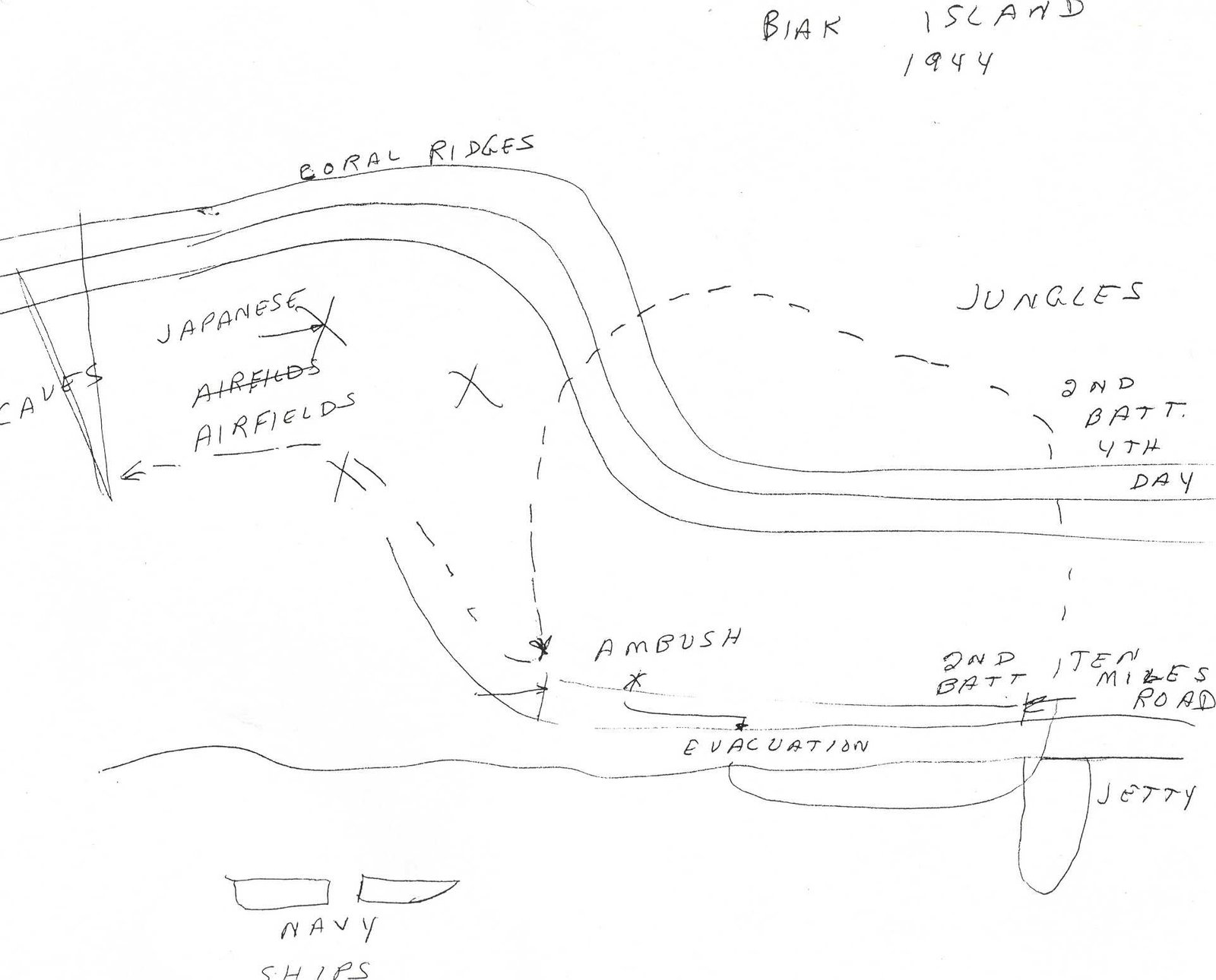Chapter 14
D-Day Plus Four… The Afternoon Engagement
It is noon as we start chopping our way through the rain forest but already we cannot see the SM. No sunlight filtrates through the thick foliage and we are in semi-darkness. The work is crippling and debilitating. We cannot use the First Battalion”s route since the enemy has closed it off. So we must create another way to the eastern ridges to bypass the initial point of contact on the beach road which is now in Japanese hands. No one can hack away at the thick foliage longer that ten minutes.
We cannot send any patrol forward, so we must trust to luck. We cannot maintain road silence, of course. But we believe that the Japanese have moved all their troops forward to protect the airfields. We feel safe, somewhat. In any case there is nothing else to do; we must reach the ridges before nightfall, so we redouble our efforts.
It is complete darkness when we hit the eastern ridges. We bivouac for the night trying to find flat spots among the rocks. It is an uneasy night. The Navy is shelling Japanese positions and we listen apprehensively as the shells pass overhead. We jump from the shock as they hit their objectives, we hope. We sleep the sleep of the dead since we are completely exhausted. No one bothers to make coffee; we are not in the mood.
We begin to climb the ridges again the following morning. This time we follow the First battalion”s route. There is evidence of a fierce fight: dead Japanese soldiers are sprawled all over the landscape, on top of rocks, in crevasses, off the main trail. Here and there we spot cloth-covered bodies. We know who they are. We hurry past the dead American soldiers. We do not wish to look at ourselves.
The plan of attack is a simple one. The Second will move out onto the plateau but will turn south and move back over the site of the ambush and connect with the Third battalion moving up the coast road. It works perfectly. E Company heads for the coastal cliffs by cutting across one of the airfields. It receives attention from the enemy from the back ridges. We ignore machine gun and artillery fire coming from caves in which the Japanese have hidden them. Since E has the largest amount of riflemen, it concentrates on the coast road. The remains of F and G Companies concentrate on the caves.
By late afternoon we hit the coast road and find ourselves in the same ambush area as on the second day, but this time we face the other way. It is an eerie feeling. We feel dispirited. This time we send scouts on top of the cliffs from which the Japanese punished us so severely. They report that the enemy is not there. They return to the company. By nightfall we occupy our old foxholes. At two A.M. the Japanese send in greetings in the form of an unremitting mortar attack. Once again E Company suffers casualties. The Navy is still out there. Two destroyers move in close to shore and return an extensive counter-fire. The night is illuminated by gun flashes, streaks of light from outgoing shells. We discover much later that the island is honeycombed with caves that the enemy cleverly exploits to move around us at will.
We move quickly to other, safer areas because we realize that the Japanese have our positions zeroed in. The company medic gets no rest. I must say a word Or two Or one thousand about the roles played by certain support troops, notably the company medics, the engineers and the Navy Seabees, the construction outfits. Never in my days overseas were we ever refused food, coffee or shelter at anyone of those support troop camps.
Dawn brings very little relief. We are told that the Third battalion needs help. So we form quickly and move on to help. We hit the enemy by surprise, for a change. The fight turns nasty. We are forced to use hand grenades and flame-throwers, wicked, devilish weapons. Some unlucky riflemen carry a double tank on their backs: one contains gasoline; the other contains a chemical. When the soldiers depress a button, both products mix and shoot out the nozzle of a long flexible tube in the form of liquid fire. The stream is directed at the mouth of caves, dugouts or fortifications.
The result is predictable. Enemy soldiers come running out as burning bodies. Out of compassion they are shot to put an end to their misery. No soldier in his right mind volunteers to carry a flame-thrower; the act of using one is suicidal.
By nightfall the Second and Third battalions link up. We forget the war as we collapse in complete exhaustion and we settle down for a good night”s rest. The artillery troops in the rear also take time out. We are all tired of the war!
Websites About Present Day Biak Island:
Biak
A database of photographs, descriptions and locations of WWII wreckage remaining on Biak Island, Irian Jaya, Indonesia.
